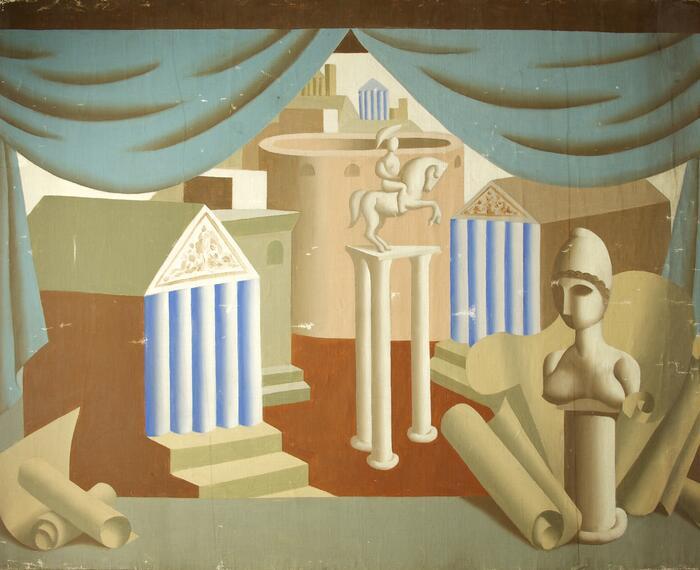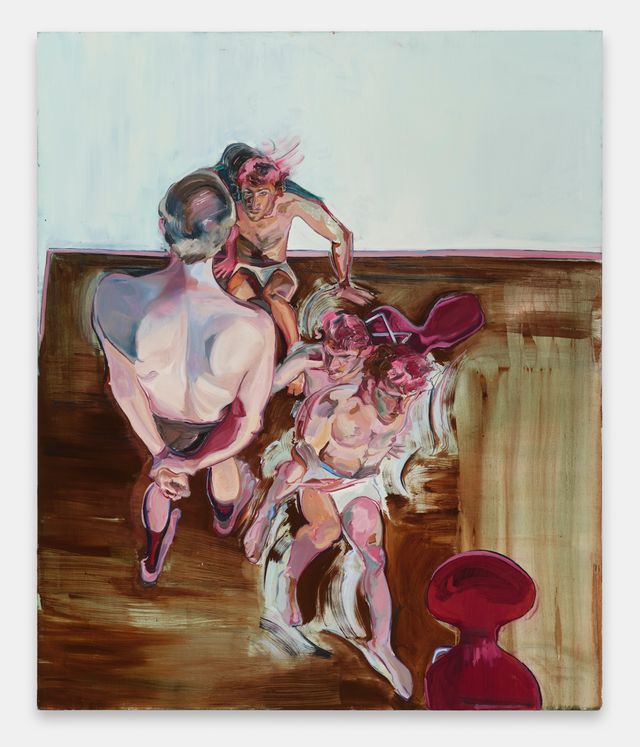


Shaqúelle Whyte, Backing off but not too far, 2023, oil on canvas, courtesy the artist / Pippy Houldsworthy photo: Eva Herzog
Pippy Houldsworth Gallery, 6 Heddon Street, London, W1B 4BT
26 April – 25 May 2024
On the end wall of Pippy Houldsworth’s bright Heddon Street gallery is a five-metre-long triptych titled Forefather, 2024. It is the largest work in this, Shaqúelle Whyte’s first show with the gallery, and it allows the artist a grand sweep in which to give full rein to themes and techniques for which he is becoming known. Over a thin wash of Italian green, a series of tableaux unfold from left to right, each emotionally intense, filmic in that the figures appear to have been captured at a mid-point in some unfolding drama. To the left, a bare-chested man slumps in a chair – exhausted, depressed, mourning, who can say? Meanwhile a woman, half her body out of frame, leans over to whisper in his ear.
All the characters appear to be in a garden, in front of a dark clapboarded building. Centre left is a long sofa where at one end a man sits at his ease, legs elegantly crossed while a white horse stands peaceably at his shoulder. A man in underwear crouches in foetal position, head bowed, at his feet, clutching at his leg. There is a sense of some desperation. At the other end of the sofa, a black-clad figure sits smoking – between them is a creepy green baby doll.To the right, a stocky figure in an almond pink shirt stands with his back to us, hands clasped, looking out to the distance – paying no attention to the pullulating pack of hounds that surges around his feet.These feral beasts could have escaped from a Francis Bacon painting.
It is hard to thread a narrative between all these scenes; the tension that Whyte conjures up tantalises, yet what is most satisfying in this, and all the larger works here, is finally the ambiguity, the combination of the familiar and the utterly strange. The artist talks about the use of animals in his paintings as being akin to spirit animals, though rather than companions, they are indicators of psychic weather. In Rabbit Heart, 2024, a dreadlocked man sits on the loo, boxers around his ankles. He is bent over, pulling at his white sports socks. There is always a real tenderness in the way Whyte delineates the body; with great economy he outlines the curve of a knee, a lean, muscular shoulder. We see the figure through an open, Victorian door – Whyte’s interiors are always so recognisable – but on the threshold of the bathroom are three fat, pinky-white rabbits. One, up on its hind legs, appears to be intent on the man on the loo. A middle one faces the viewer. But then a third lies on its back, legs akimbo, and suddenly you’re not sure if it’s a toy, or a dead rabbit, or what, and the whole proposition is destabilised.
Whyte uses friends and family as models, bringing them into the studio and directing their positions like a stage or film director. But more than picturing their bodies, one has the sense of the paintings being scenes from the life of a close-knit group of friends. A painting like Kevin, you’re next, 2024 feels like lived experience. A diptych, it presents two views of a street fight among a group of young men. It distils both the beauty and the cruelty of youth: the hand that tugs on someone’s t-shirt, the camaraderie, the bullying. The left-hand panel places the viewer right there in the scrum, the right-hand one pans back again to a more dispassionate viewpoint. These could almost be frames from movie.
Whyte studied for his undergraduate degree at the Slade and moved to the RCA for his Masters, graduating only two years ago. Since then, he has been part of a slew of group shows, in Turin at the Palazzo Capris in 2022, at the Saatchi Gallery in London the same year and at Hauser and Wirth in Somerset earlier this year. His range of artistic references ranges very wide, from Renaissance masters to grandees of 20th century British figurative painting like Euan Uglow and feted contemporary painters such as Michael Armitage. Whyte is an artist who has looked hard at a lot of paintings. Mark Rothko is a touchpoint for him, for his deep involvement in the physicality of paint as much as for his use of colour to evoke emotional states. The big paintings Ivory Tower, 2024 and Backing off, but not too far, 2023, deploy multiple renditions of the same figure with a technique that channels Eadweard Muybridge’s early photographic experiments; it allows for the painter to create temporal as well as spatial shifts, and a dynamic, if oblique narrative within one canvas. Ivory Tower has a spectral, red figure moving from the left of the canvas to self-consciously take a bow, centre stage, his gaze fixed on the viewer while an unseen character applauds from the wings. Is this a metaphor for the life of the artist, who leaves the solitude of the studio to stand in the spotlight? And if so, what is the significance of the naked figure, apparently unconscious on the sofa in the background, and are they even in the same room?
Shaqúelle Whyte’s paintings manage to produce strangeness and ambiguity without ever appearing mannered or portentous. He maintains a lightness of touch and a directness that I assume comes from translating his own life into the work and a compelling painterliness that goes far beyond mere facility in the medium. You have just one month in which not to miss this show.
Caroline Douglas
Director
Shaqúelle Whyte: Yute, you’re gonna be fine
Pippy Houldsworth, 6 Heddon St
London, W1B 4BT